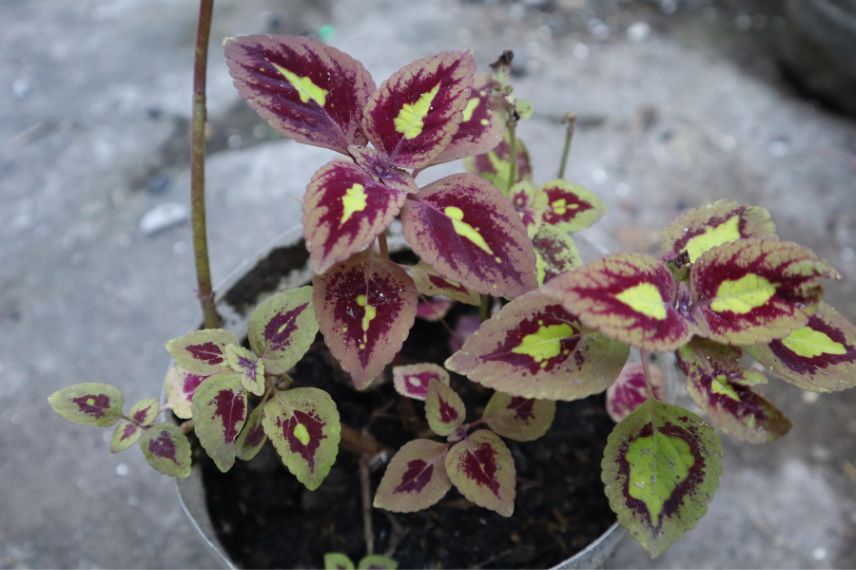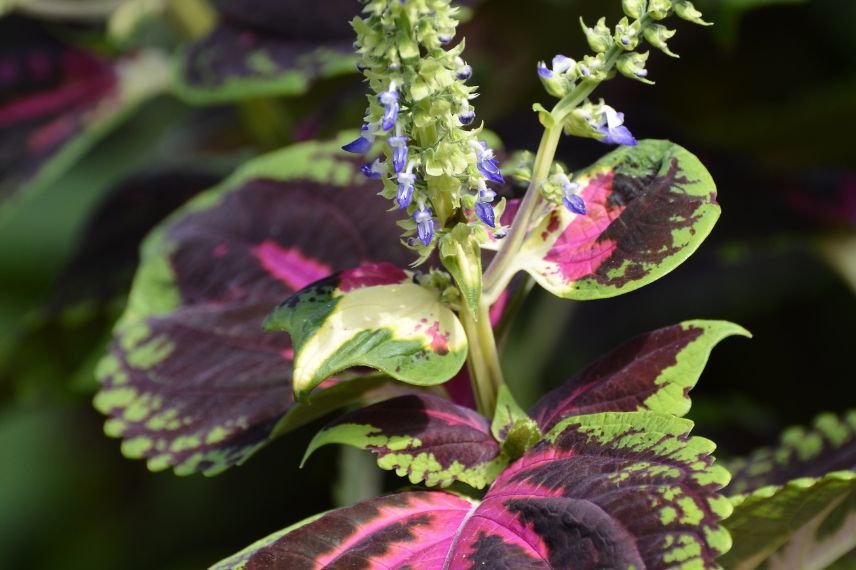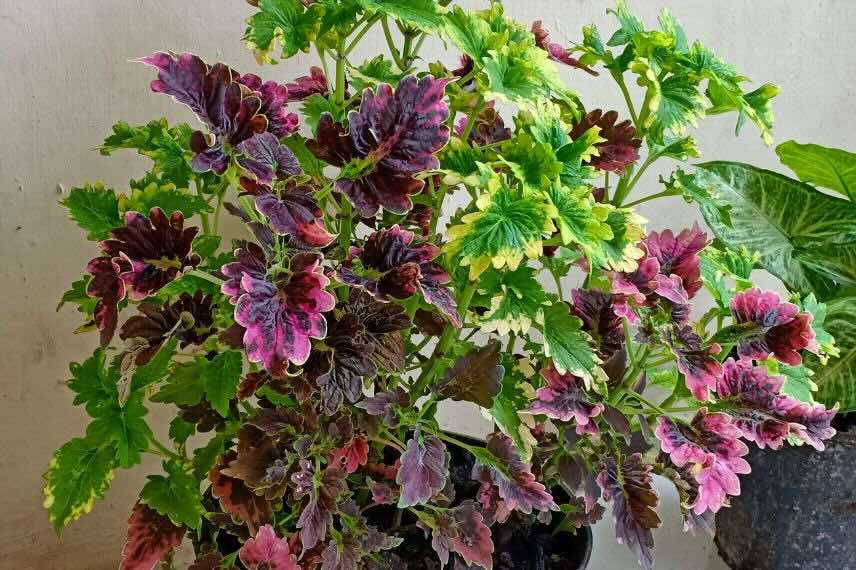
Indoor Coleus: Care Through the Seasons
For a healthy indoor plant throughout the seasons
Contents
The Coleus, also known as Solenostemon or Plectranthus, is a popular houseplant prized for its variegated foliage with often spectacular colours. Easy to propagate from cuttings, Coleus adds a vibrant and cheerful touch to our interiors. To maintain its brightly coloured leaves and compact habit, potted Coleus requires seasonally adjusted care.
To encourage growth, prevent it from becoming leggy as it reaches for light, or to keep it healthy during the darkest months, it’s essential to adjust watering, light exposure, pruning and nutrient intake throughout the year. Discover in this seasonal guide how to properly care for your Coleus to keep it beautiful and vigorous.
Spring: The Revival of Growth
With the return of longer and brighter days, the Coleus gradually emerges from its winter dormancy. Spring marks the beginning of an active growth period, and it’s the ideal time to give potted Coleus a little boost to help it get off to a good start.
Spring Pruning
In early spring, light pruning is highly recommended. This helps to:
- remove stretched or bare stems formed during winter,
- stimulate branching,
- encourage a compact, bushy shape.
You can pinch the tips of the stems (cutting just above a node) to promote the emergence of new lateral shoots.
Repotting if Needed
If the indoor Coleus grew well the previous year, its roots may start to run out of space. Spring is then the right time to:
- repot into a slightly larger container,
- refresh the compost with a fresh, light, and well-draining mix (a quality houseplant compost with some perlite works well).
Repotting also helps kickstart growth by providing fresh nutrients.
Gradual Resumption of Watering
In winter, Coleus is watered sparingly. In spring, as the plant starts growing again, its water needs increase. However, avoid overwatering:
- the compost should remain slightly moist but not soggy,
- wait until the top few centimetres of the substrate dry out between waterings.
Resuming Nutrient Supply
As soon as growth resumes (new leaves, lengthening stems), you can start feeding the plant with a liquid houseplant fertiliser, once a month. It’s best to start gently, with a slightly lower dose than recommended, then gradually increase.
Appropriate Light Levels
Coleus needs light to develop its beautiful colours, but direct sunlight can damage the leaves. Spring, with its moderate sunshine, is a good time to place the plant near a well-exposed but filtered window (east or west-facing, or south-facing with a light curtain), gradually acclimatising it to brighter light in preparation for summer.

A light spring pruning is recommended for Coleus, which grows quickly and can become a bit leggy
Read also
Coleus: sowing, planting and careSummer: rapid growth and vigilance
Summer is a period of intense growth for Coleus. With high temperatures and long days, the plant can produce abundant foliage, often very colourful. But this season also requires increased vigilance, as excessive heat, light or drought can harm its health.
Regular and monitored watering
Coleus has a high water requirement in summer, especially if placed in a bright and warm spot. It cannot tolerate prolonged drought: its leaves may wilt quickly if the compost dries out completely.
- Water as soon as the surface of the compost begins to dry out.
- During heatwaves, this may mean almost daily watering, depending on conditions.
- Always avoid water stagnating in the saucer: good drainage is essential.
Regular pruning
To prevent Coleus from going to seed or becoming too straggly, it’s useful to pinch back the stems regularly, i.e., cut the tips above a node. This helps to:
- densify the plant,
- maintain a balanced habit,
- prolong the vegetative phase.
If flowers appear, they can be removed to prevent the plant from becoming exhausted or less attractive. The variegated foliage of Coleus is the real star!
Fertiliser to support growth
With such active growth, regular fertiliser application is beneficial.
- A balanced liquid fertiliser for foliage plants (or one with higher nitrogen content if foliage is prioritised) every 2 to 3 weeks is recommended, but avoid overfeeding to prevent leggy stems.
- If the plant was repotted in spring in enriched compost, you can wait a few weeks before starting.
Vigilance against parasites
Summer is conducive to the arrival of unwanted pests:
- Aphids, whiteflies and sometimes red spider mites thrive in hot, dry conditions.
- Regularly checking the undersides of leaves allows for early detection of infestations.
- If pests are present, you can treat with black soap or gentle solutions (or even isolate the plant temporarily).

Continue pinching back stems in summer if growth is vigorous, and remove flowers to encourage foliage
Autumn: slowing down gently
As autumn sets in, the days grow shorter and the light becomes less intense. The Coleus naturally begins to slow its growth. This is a gentle transition period, during which you should gradually adjust care to help it enter the cold season smoothly.
Gradually reduce watering for indoor Coleus
With the drop in temperatures and light, the plant consumes less water.
-
It’s therefore important to let the compost dry out more between waterings, while avoiding letting it dry out completely.
-
Watering remains regular as long as temperatures stay mild, but should be gradually spaced out.
Light pruning and cleaning
Autumn is a good time to:
-
clean the plant, removing damaged or yellowing leaves,
-
lightly prune overly long or bare stems,
-
refresh the shape of the Coleus before winter.
This helps maintain a compact form and prevents the plant from weakening by sustaining unproductive parts.
Reduce then stop fertiliser applications
As growth slows, nutrient requirements decrease.
-
You can space out fertiliser applications from mid-September.
-
Then stop completely by late October, unless the Coleus continues to grow actively (which is rare without supplementary lighting).
Optimise light
Coleus needs good light to maintain its vibrant colours. In autumn, you may need to:
-
move the plant closer to a well-exposed window (ideally south or west-facing),
-
consider supplementary lighting if the room becomes particularly dark.
Coleus cuttings
Autumn is also an interesting time to take some cuttings, in case the mother plant doesn’t overwinter well.
-
Stems cut during pruning can easily be rooted in water or moist compost.
-
These cuttings will produce vigorous young plants to keep or share.
Winter: Relative Rest and Vigilance
In winter, Coleus enters a period of marked slowdown, even near dormancy depending on conditions. It doesn’t die, but its growth almost completely stops. At this stage, the goal is to preserve the plant without forcing it, while avoiding common mistakes related to watering and light.
Very moderate watering
Coleus, like many tender-leaved plants, fears both cold and stagnant moisture.
-
In winter, watering should be spaced out, but if you notice the foliage softening, water a little more.
-
Excess water in a cool atmosphere can cause root rot or foliage collapse.
No fertiliser
During this rest phase, the plant barely consumes nutrients.
All fertiliser applications should be completely suspended until growth resumes in spring. Applying fertiliser in winter could weaken the roots or promote unbalanced development.
Maximum light
One of the biggest winter challenges for Coleus is lack of light.
-
If the room is dark or the days are very short, using horticultural lighting can be considered to prevent discolouration or stem etiolation.
Stable temperature and mild environment
Coleus is a tropical plant that doesn’t appreciate cold.
-
The temperature should not drop below 15°C. Ideally keep the plant above 18°C.
-
Cold draughts and sudden temperature changes (near a poorly insulated door or window) should also be avoided.
-
Avoid placing it too close to a radiator as well: overly dry air can cause leaf desiccation.
Why is my coleus losing its leaves?
It’s common for Coleus to lose some leaves in winter. This doesn’t necessarily mean it’s unhealthy.
-
As long as the stems remain firm and there are some healthy leaves, it can bounce back vigorously in spring.
-
In case of advanced decline, cuttings set aside in autumn can provide good replacements.

Favour the brightest possible location
- Subscribe!
- Contents
































Comments